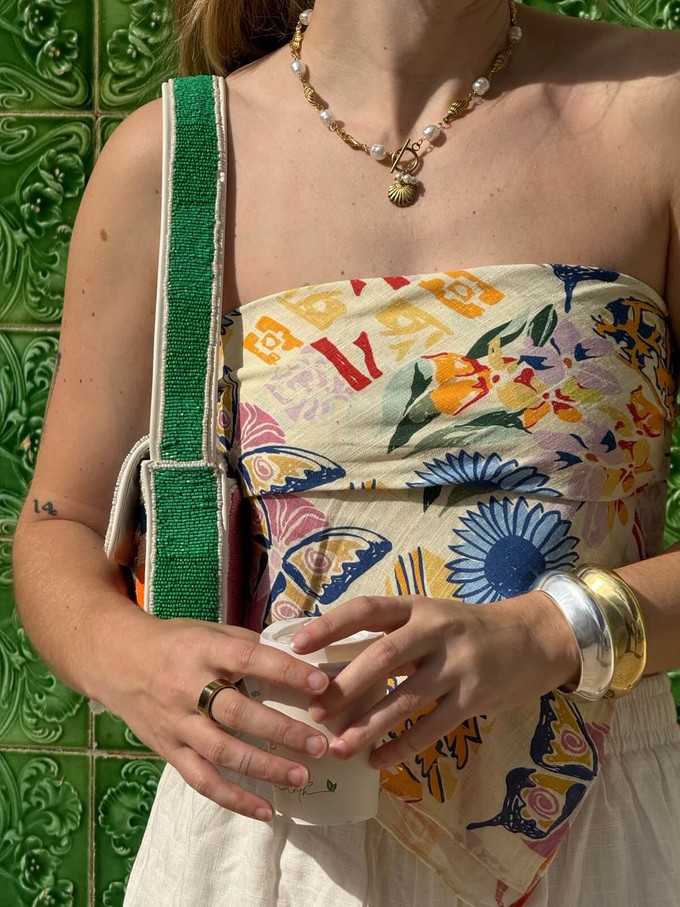- Clothes
- Bags
- Accessories
-
Inspiration
- Shoes
From Micro-Trends to Long-Term Love for Your Clothes: 7 Steps

To justify the environmental footprint of a garment, we should wear it at least 30 times… and yet fast fashion has brainwashed us into seeing our clothes as throwaway items.
The fact you’re here tells me you’re open to changing your mindset (sending you a virtual high five). You might struggle to break free from overconsumption and micro-trends, though.
So, take it from someone who used to be trapped in the same cycle: it can feel challenging at first, but it’s totally doable. And once you get used to it? You’ll feel the difference and wonder “Why didn’t I start sooner?”
The problem with micro-trends and seeing clothes as disposable

Fashion used to only have a spring/summer and autumn/winter season. Now, it’s moving faster than ever, with ever-changing trends and 52 micro-seasons per year.
Basically, to keep up, you’d need to buy new clothes every week… and many consumers do.
But here’s the problem with following fast fashion’s micro-trends:
- Bad for the environment – Fast fashion brands produce cheap clothes with a high environmental cost. So, from high carbon emissions to toxic chemicals and fabrics that take centuries to decompose, they pollute the environment and contribute to climate change. Their entire business model is based on overconsumption: consumers are pushed to keep buying clothes, only wear them a couple of times, discard them, and start again. No wonder it generates 92 million tonnes of textile waste every year. Instead, keeping an item for just 9 additional months reduces your carbon, water, and waste footprint by 20-30%
- Bad for garment workers – These brands often rely on child labour and sweatshops where underpaid workers are trapped in modern slavery conditions
- Bad for you – Chasing micro-trends affects your brain, keeping you trapped in a vicious cycle of needing new clothes to get a dopamine hit and feel worthy. It also removes your sense of self-expression. Plus, while those items might be cheap… it adds up! The average consumer spends £526.50 on clothing every year
Loving your clothes long-term ≠ boring

I used to be stuck in that cycle too. When Primark opened a new branch in the Netherlands, I literally took a train to a different city to do a massive haul.
The more I learned about the true cost of fast fashion and micro-trends, though (actually, The True Cost is literally the documentary that did it for me), the more I started moving away from them.
However, at first, I was also worried that embracing slow fashion would feel limiting and boring. Instead, I found the opposite to be true.
My mother was a big inspiration because she kept so many beautiful garments from +30 years ago (something I’m now striving to do too). It even became a running joke in my friend group: whenever I show up with something particularly nice or eye-catching, they ask me if I’m wearing my mum’s clothes.
Anyway, what I’m confident you’ll value is:
- Freedom – You’re not restricting yourself: you’re freeing yourself from the pressure to keep buying clothes
- Creativity and self-expression – You’ll only wear clothes that feel “you”
- Meaning – Once you fall in love with fewer clothes, you’ll feel a stronger connection with them
- Saving money – Yes, higher-quality clothes (made ethically and to last) tend to be more expensive. But when you buy less and keep them for longer? Their cost per wear goes down massively, and you usually save money in the long run
How to go from micro-trends to long-term love for your clothes in 7 steps

1. Find your style
Stop looking for external approval or rules, like buying clothes just because they’re trending on TikTok. Start from YOU:
- Whether it’s an aesthetic, colour palette, or style, what type of clothes and outfits feel “you”? (If you need some help, bookmark our guide to finding your signature style)
- Think beyond (micro)seasons and trends: identify a timeless style
- Create a moodboard to stay inspired
2. Declutter your wardrobe
If your closet’s full of fast fashion pieces you only bought to follow someone else’s trends… of course, you always find excuses not to wear them!
- Take everything out, look at each item individually, and decide what to keep (for example, does it match your signature style? Does it fit you comfortably?)
- Don’t bin your discarded clothes! Sell them online, give them to friends who’d actually wear them, or donate them to trusted organisations like local shelters
- This is also a great opportunity to digitise your wardrobe
3. Plan ahead
- Be aware of what you find most challenging about ditching micro-trends (for example, peer pressure or FOMO). Then, figure out how you can make that easier for yourself, like unfollowing accounts who promote overconsumption
- Get clear on what motivates you. Use it as a reminder or turn it into a positive affirmation and have it on your phone or a post-it note
4. Help your clothes last longer
Fast fashion items are literally designed to fall apart. Still, as well as buying fewer but higher-quality pieces from now on, you can:
- Store your clothes nicely so they can breathe (decluttering your wardrobe makes a big difference!)
- Wash them less (for example, let them freshen up next to an open window or use natural fabric freshener), and when you do, protect them with mesh bags and lower temperatures
- Skip the tumble-dryer
- If something goes wrong, mend that item, or take it to a stitcher
5. Get creative
- Combine your existing clothes in creative ways to unlock new outfits (that’s where a digital wardrobe app comes in handy)
- Accessorise them to get even more out of them
6. Embrace repeat outfits, too
- Reject the unsustainable idea that we shouldn’t be seen wearing something too often (says who?! Don’t our favourite characters have a handful of iconic outfits, too?)
- Notice the difference: don’t you feel more aligned and energised whenever you rewear outfits that feel “you”?
7. Shop mindfully
Ditching micro-trends doesn’t mean you can never, ever buy new clothes! When you do, simply:
- Be mindful. For example, ask yourself: do I genuinely want this? Does it match my style, or is it a random trend? Will I wear it at least 30 times?
- Choose higher-quality, durable, and ethical clothes made by brands that care about both the planet and garment workers. On Project Cece, you can find hundreds of sustainable brands in one place, with filters to narrow down your choices
Chasing micro-trends is about to become out of fashion for you. So, enjoy this new, meaningful clothing lifestyle that’s bound to wrap you in joy and purpose.
Share our story
Project Cece is a platform that collects ethical fashion from vetted brands and shops in one place. Browse ethical fashion for women and men and find items that fit your style, budget and values!
_large.png)